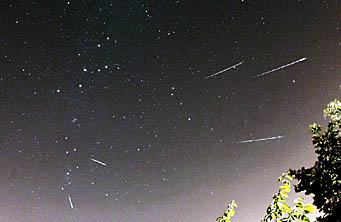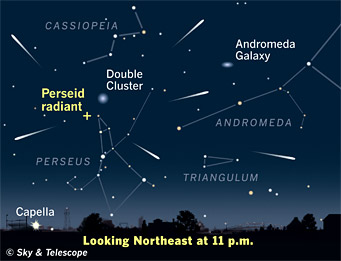Whenever you're out astronomizing during this time of year, you're likely to notice an occasional meteor that streaks away from the direction of the constellation Perseus, which is rising in the northeast during late evening. Those streaks are the calling cards of the annual Perseid meteor shower.

Gain Lee recorded this montage of bright Perseids over a two-hour period last August 12-13 from his heavily light-polluted backyard in Huddersfield, England. He took many short exposures with a 15-mm f/2.8 fisheye lens, then combined the lucky few that captured a meteor with one that included the foreground. Click on the image for a wider view, which shows Cassiopeia near center and the shower's radiant point below it in northern Perseus. The nonconformist meteor off by the Big Dipper at far left is a Kappa Cygnid.
Gain Lee
The Perseids are at least a little active throughout early and mid-August, and in fact we received reports that the shower was under way by August 5th or 6th.
But the night or two around the shower's maximum are what bring out the crowds. This year the Perseids should peak on the morning of August 12th, around 11h to 14h Universal Time. That's 4 to 7 a.m. Pacific Daylight Time, good timing for North America and especially the Far West. But wherever you're located, from midnight to dawn is the best time to watch.
Clear and dark skies permitting, you should be able to spot lots of Perseids this year — but only if you dodge the light of the waxing gibbous Moon. The Moon hangs around until as late as 1 or 2 a.m. daylight saving time on the morning of the 12th, depending on where you live in your time zone. But after that, you get nearly three hours of darkness before the first stealthy glimmer of dawn. The Moon sets earlier by nearly an hour per day on preceding nights, and about an hour later each night thereafter.
(To find your local times of moonset and the start of dawn, put your location and time zone into our online almanac. If you're on daylight saving time like most of North America, make sure the Daylight Saving Time box is checked.)

The Perseid meteors appear to stream away from their radiant near the border of Perseus and Cassiopeia. And while you're outside on a dark night, don't forget to look for the Double Cluster and the Andromeda Galaxy, two of the easiest "faint fuzzies" to spot with your unaided eyes.
S&T Illustration
Fortunately, the brightest meteors will show right through the moonlight. But before 11 p.m. or midnight, there won't be as many of them in any case. Early morning your time is when your side of Earth faces most directly into oncoming meteors — Perseids included.
Find a spot with an open view of the sky, wrap up warmly in winter clothes and a sleeping bag (it gets cold under a clear sky late at night!), and don't forget the mosquito repellent. If you have a good, dark sky, you may see a meteor zipping into the upper atmosphere about once per minute on average.
Perseids can flash into view anywhere in the sky, so watch whatever part of your sky is darkest. But all of them, if you trace their paths far enough backward, appear to be radiating from a point in northern Perseus below Cassiopeia.
You won't need any kind of optical aid to enjoy the Perseids — it's a wonderful opportunity for "eyeball astronomy." Some observers like to keep a careful meteor count. If you do this by certain standardized methods, you can report your count to the International Meteor Organization or the North American Meteor Network to help track the shower's behavior from year to year. If that interests you, read more.
You may also see occasional meteors from two lesser showers that are active at the same time: the Delta Aquarids and Kappa Cygnids. These meteors move noticeably slower than Perseids. And then there are that sporadics, members of no organized shower at all, that occasionally punctuate the night.
Good luck! And use the comment section below to let me know how the Perseids looked from your location.
Algol Bonus!
While you're watching for Perseids on the morning of the 12th, keep an eye on Algol, Beta Persei. This famous eclipsing binary star should be at minimum light, magnitude 3.4 instead of its usual 2.1, from about 2 to 4 a.m. Tuesday morning Eastern Daylight Time (6:00 to 8:00 Universal Time). Algol takes several additional hours to fade and to rebrighten. Here's a naked-eye comparison-star chart.
 13
13









Comments
Dave
August 8, 2008 at 2:20 pm
Love it! I've used that term for a while and this is the first time I have seen someone else use it too. 🙂
You must be logged in to post a comment.
GeorgeE
August 8, 2008 at 4:31 pm
Aug. 11, 1985: I leave the hospital late after helping my third child get born around 7:30 p.m., and can't sleep; a couple of friends come over; we watch a fine Perseid display all the way to dawn on Aug. 12. Ever after he's been the Perseid birthday boy and we still watch the show every year on his birthday night!
You must be logged in to post a comment.
scout 89
August 9, 2008 at 8:28 pm
I am a boyscout and I am going o a especial camp-out to see the meteor shower this agust 12 and this article (I think) will help me alot at the meteor shower whaching whit my patrol.
You must be logged in to post a comment.
Luis
August 11, 2008 at 1:39 am
I have a few friends who want to get together and see the Perseid meteor shower. My problems is I am not sure if the location I picked will be adequate for viewing. The area is called Lake Findley and it is a few miles outside of town. there are no lights that I recall and the sky is usually clear in this area. I tried to use the online almanac but it reads like stereo instructions to me.
Location: Alice (South)Texas.
Time: Central Time.
coordinates to Lake Findley:27° 47′ 31.2″ N, 98° 3′ 51″ W
Decimal:27.792°, -98.064167°
UTM:3074513 592192 14R
If anyone could help me or point me in the right direction it would be much appreciated.
Thank you.
You must be logged in to post a comment.
John
August 11, 2008 at 2:59 pm
Saw a great (Early persiedi?) fireball Saturday night, nice bright green-yellow, and a long ion trail across the sky. Nicest I've seen in a while. Mybe the precursor to a good show?
You must be logged in to post a comment.
Jon Hanford
August 11, 2008 at 5:46 pm
If you can see the Milky Way from your location in Texas you should by just fine, Follow the instructions mentioned in the Perseid article(s) @ S&T and enjoy.Be sure to look all around the sky, even near the setting moon, as Perseids can appear anywhere in the sky. If you have a few fellow observers with you, possibly divide up large areas of the sky to scan to increase everyone's chances to catch some meteors. Also, a simple pair of binoculars can come in handy if a bright fireball is seen, as they usually leave behind a trail (or train) that can persist for a few minutes. Good luck & clear skies.
You must be logged in to post a comment.
Luis Rosales
August 12, 2008 at 2:24 am
I appreciate the help.
You must be logged in to post a comment.
Sandy Bump
August 12, 2008 at 2:29 am
Even though city lights and clouds hampered viewing here in Fond du Lac, Wisconsin, we saw more than a dozen bright and beautiful meteors with long tails between 0100-0300 Central Time on August 12th, 2008... no binoculars needed!
You must be logged in to post a comment.
Dave
August 12, 2008 at 8:04 am
Enjoyed a few, maybe 20, Perseids observing from near NW of Salida, CO between 1:00 and 2:00 AM Tuesday the 12th. Some had good sized tails on them. When the sky is clear here, not often in the summer, there is reasonalbe viewing from the Arkansas River valley although there is some light pollution in the ENE resumeably from Denver.
You must be logged in to post a comment.
Mark
August 12, 2008 at 10:07 am
Any notion out there on the residual showers for this evening 12 August into morning 13 August in New England? We've been socked in with rain and clouds for days and tonight is likely to be a clear evening.
Thanks,
Mark
You must be logged in to post a comment.
Melanie
August 12, 2008 at 11:29 am
Mark practically took the words right out of my mouth. I was planning to watch the Perseids this morning, but it was all cloudy, and rained later. Wednesday night/Thursday morning is supposed to be mostly clear - what will I be able to see then? Thanks!
You must be logged in to post a comment.
hunter
August 12, 2008 at 5:22 pm
I went out to watch the perseids with some friends and family out on the boat. It couldnt of been more than 20 mins after sun down when i was preoing the boat that i saw the brightest fireball of my life. it left a nice trail acrross the entire sky. it was beutifull. we saw about 35 meteors after that but non of them were anywhere near as beautiful as that first one. And of course everyone else was inside when it happened to escape the mosquitos but thats ok i geuss.
You must be logged in to post a comment.
shakirafan219
August 13, 2008 at 2:33 pm
At 1 am on August 12, I went to watch Perseids in my backyard. I live near Seattle. It was completely clear, with no haze or clouds. There were no obstructions. I watched for half an hour and saw 15 meteors, 5 of which were large fireballs. Just before I saw the brightest one, about mag. -6, I heard a weird popping-whistling noise. Can fireballs make noise?
You must be logged in to post a comment.
You must be logged in to post a comment.